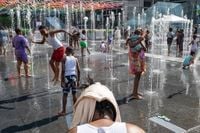Philadelphia is bracing for a blistering heat wave that could shatter records and test the city’s resilience as temperatures climb to dangerous heights from Sunday through Wednesday. This early-season blast of heat, with highs expected between 97 and 102 degrees and feels-like temperatures soaring up to 110 degrees, marks the first time in 13 years that the city may hit the 100-degree mark.
The National Weather Service has issued an extreme heat warning stretching from June 22 to June 25, covering all Pennsylvania, New Jersey, and Delaware counties along the Interstate 95 corridor. Meanwhile, Philadelphia’s Department of Public Health has declared a heat health emergency effective noon Sunday through Wednesday night, activating emergency heat programs including more than 40 cooling centers, outreach teams, and the Philadelphia Corporation for Aging’s Heatline.
“You’re looking at numerous daily high records,” said Zack Taylor, chief of the analysis section at NOAA’s Weather Prediction Center. “High temperatures and perhaps more ominously, morning lows.” Indeed, overnight lows are expected to hover near 80 degrees, offering little relief from the heat with the potential for record-setting high minimum temperatures.
The city’s heat wave comes with additional challenges. A code orange air quality alert is in effect for the Philadelphia region (except the Poconos, Lehigh Valley, and Berks County) until midnight Sunday, urging those with respiratory or heart conditions to limit outdoor exposure. The combination of extreme heat and poor air quality raises the risk for heat-related illnesses such as heatstroke and heat exhaustion.
Adding to the threat, isolated pop-up storms could develop daily due to the heat and humidity, with the possibility of severe weather including wind, hail, downpours, and lightning. However, forecasters expect mostly full sunshine during the heat wave, driven by high pressure systems that discourage rainfall and cloud cover.
Laurence Kalkstein, a climatologist and heat-mortality expert who helped Philadelphia develop its pioneering heat-response system in the 1990s, underscored the danger of this heat wave. “People are unacclimatized, and they are much more likely to get sick or die,” he explained, highlighting that the generally mild weather so far this year has left residents vulnerable.
Temperatures on Monday and Tuesday could break records for those dates, with highs possibly cracking the 100-degree barrier—the first time since July 7, 2012, when Philadelphia reached 101 degrees. “Those rowhouses literally become brick ovens,” said Lawrence Robinson, a former city health official instrumental in the city’s heat-response planning. The lack of nighttime cooling means that homes, especially in densely populated areas, will retain heat, compounding health risks.
Philadelphia is mobilizing to help residents weather the heat. The city has opened more than 40 cooling centers and activated the Heatline, which will operate from noon to 8:30 p.m. Sunday and 8:30 a.m. to 8:30 p.m. Monday through Wednesday. Special outreach efforts target vulnerable populations, including home visits by field teams and enhanced services for people experiencing homelessness.
Health officials advise residents to stay hydrated with nonalcoholic, non-sugary drinks, spend as much time as possible in air-conditioned spaces, and take cool showers if overheated. Never leave children or pets unattended in cars, as temperatures inside can quickly reach deadly levels. Pets should be kept indoors or in shaded areas with access to clean, cool water, and dog owners are urged to avoid walking their animals on hot pavement to prevent paw burns.
Despite the severity of this heat wave, Philadelphia’s heat-related death toll has declined dramatically in recent years. Between 1993 and 2002, the city recorded 400 heat-related deaths over a decade, but since 2013, fewer than 50 such deaths have been reported during summer months—a testament to improved public health measures and community outreach.
Still, the threat remains real. NOAA’s HeatRisk forecast highlights a “magenta” zone—a level 4 on a 1-to-4 scale—signifying “extreme heat with little to no overnight relief” across the Mid-Atlantic and upper Midwest from Sunday through Tuesday. Zack Taylor cautioned, “It’s going to be a fairly extended period of higher heat.”
Looking ahead, the heat wave is expected to break by Thursday, when afternoon storms may bring some relief with highs dropping to the mid-90s. Scattered storms and cooler temperatures in the 80s are forecast for Friday and Saturday, offering a much-needed cooldown after days of relentless heat.
For those seeking respite beyond the region, the Pacific Northwest and northern Rockies promise cooler weather with highs in the 40s, 50s, and 60s, and even snow at the highest elevations—a stark contrast to the sizzling conditions in Philadelphia.
As the city prepares for this intense heat wave, the message is clear: take precautions seriously, check on neighbors and loved ones, and use available resources to stay safe. With the heat set to bake the region for several days, vigilance and community care will be essential to weather this sweltering challenge.

